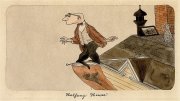In shopping malls around the country, medical businesses sell ultrasound and CT (computed tomography) scans to healthy but vigilant customers. These body scans, which may cost several hundred dollars, allegedly can detect conditions like cancer and arterial blockage at early stages, and thus cue patients to seek "preventive" treatment. Body scanning is only one of many interventions aimed at detecting ailments early, or preventing them entirely. Childhood vaccines render a slew of diseases harmless before they can strike. Self-examinations are promoted as a quicker way to find lumps and moles before they can grow. And an array of blood tests and other kinds of imaging tests looks for tumors and malignancies at earlier and earlier stages.
But is the premise of preventive medicine being stretched too far? "Yes," says Eric Schneider, assistant professor of medicine at Harvard Medical School and the Harvard School of Public Health. Schneider's research indicates that many aggressive techniques for preventing illness are useless and costly; they can even generate new medical problems. Schneider calls it "prevention creep""the notion that we can take strategies designed for public health and large populations and modify them almost at will to be applied in clinical situations to individuals."
For example, Schneider was the lead investigator in a study of angioplasty, a technique in which surgeons insert a deflated balloon into a coronary artery blocked by plaque and then inflate the balloon to flatten and disperse the plaque. Angioplasty is a proven way to save the lives of patients who have just had a heart attack, and about a million were done in 2000. But more than two-thirds of the 828 angioplasties in Schneider's study were performed on patients who had experienced no heart-attack symptoms. Instead, they simply showed signs of coronary arterial narrowing. In such cases, angioplasty has been moved back a step in the process, from treatment to prevention. Fineexcept that the narrowing of coronary arteries is considered a poor indicator of future heart attacks, and the majority of the angioplasties performed in Schneider's study afforded their patients no definitive benefit. In fact, in 14 percent of the cases, the invasive operations were completely inappropriate.
Prevention creep is hardly limited to angioplasties. Tests formerly given to patients with symptoms are now applied to healthy people as a preventive strategy. Newer, more powerful diagnostic tests and imaging technologiessuch as prostate-specific antigen (PSA) testing to detect signs of prostate cancer in the blood and spiral CT scanners that search for tumorspresent snapshots of what's happening inside the body, turning up more and more potential health problems at earlier stages. "What we don't always recognize, though," says Schneider, "is that the overwhelming majority of what we see in these tests is benign, and will never develop into anything."
The proliferation of medical tests generates more and more information, much of it ambiguous. But once something is known, doctors and patients often share an irresistible urge to do something about it: the cardiologist who sees narrowed arteries tends to reach for a prescription pad or a stent.
Invasive treatments are often performed inappropriately, because many tests, like the PSA, produce a plethora of false-positive results, suggesting cancer where there is none. Nonetheless, tests invariably lead to more testslike biopsiesto ascertain whether the lump or mass noted on the scan is malignant. Frequently, this means surgery, adding an aspect of risk to what may be an otherwise meaningless pursuit. Prostate surgery, for example, often makes men impotent, incontinent, or both.
Some of these procedures work. Few would dismiss the efficacy of Pap smears or colonoscopies in the early detection of cervical or colon cancer. But many new procedures or tests, or even old procedures used in new ways, need a time lag to evaluate their usefulness. There isn't any clear evidence, for example, that mammography or PSA screening has in fact reduced mortality from breast or prostate cancer. To help separate the known from the unknown, the U.S. Preventive Services Task Force reviews all scientific evidence for or against the different preventative interventions and then grades them accordingly (www.ahcpr.gov/clinic/cpsix.htm).
"It is a difficult situation," says Schneider. "Patients want relief from uncertainty, doctors want to offer them something, and these tests can provide a sense that more knowledge is possible. In the name of prevention, doctors and patients undertake a collaborative effort that sometimes leads to tests or procedures that might not be in the patient's best interest."
~Jerry Shine
Eric Schneider e-mail address: eschneid@hsph.harvard.edu





